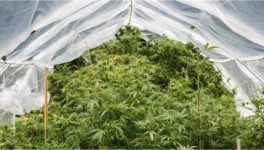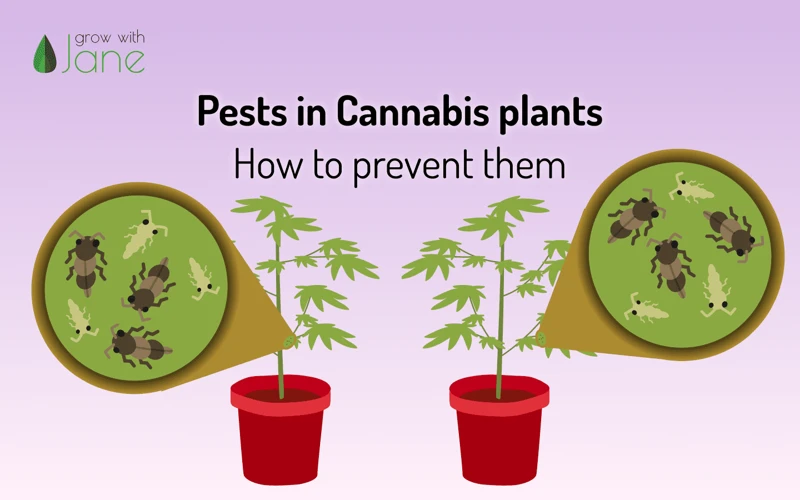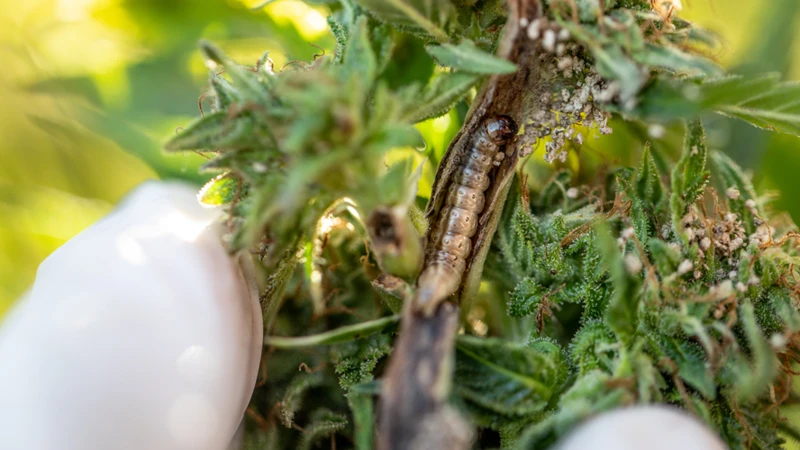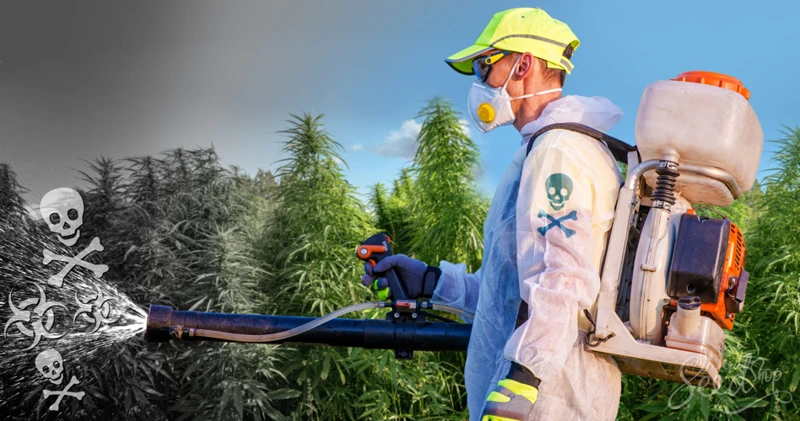
Is Chemical Pest Control Right for Your Cannabis Plants?
Growing cannabis is a meticulous process that requires careful attention to detail, especially when it comes to pest control. Pests can cause significant damage to the crop, leading to lower yields and even complete loss. There are many methods of pest control, but chemical pest control is one of the most commonly used approaches. While it has its advantages, there are also some drawbacks to using chemical pesticides. In this article, we’ll explore the pros and cons of chemical pest control for growing cannabis, as well as alternative organic pest control methods.
What is Chemical Pest Control?
Contents
Chemical pest control refers to the use of various chemical compounds, typically insecticides and pesticides, to manage pests that can damage or destroy crops, including cannabis. These chemical solutions are designed to eliminate harmful insects, fungi or other detrimental organisms that could otherwise compromise the growth, potency or yield of cannabis plants.
Different types of chemical pest control methods can be applied at different stages of plant growth or cultivation, including in the soil, during vegetation and flowering periods or during curing and storage. Some of these chemical compounds include pyrethroids, organophosphates, neonicotinoids, and carbamates.
However, it is important to note that chemical pest control can have negative side effects, including harm to the environment, residual effects on plants, and negative impact on beneficial insects. It is crucial to understand both the benefits and drawbacks of this approach before deciding to use it in the cannabis growing process.
Pros of Using Chemical Pest Control for Growing Cannabis
When it comes to growing cannabis, one of the major concerns that growers face is how to deal with pests. While there are several options available, chemical pest control is a popular choice for many growers. The use of chemical pesticides and insecticides can be highly effective in controlling pests and ensuring a healthy harvest. Let’s take a closer look at some of the main advantages of using chemical pest control for growing cannabis.
1. Effective Control of Pests
Chemical pest control is an effective way to manage the pest population in cannabis crops. The use of synthetic pesticides and insecticides is a powerful tool to combat insects and other pests that can cause significant damage to the plants. Chemical pest control products are specifically designed to target various pests, including mites, aphids, and thrips, among others.
One of the primary benefits of chemical pest control is its efficacy against pests. Chemical pesticides are typically stronger and more powerful than natural pest control methods, providing growers with an effective solution to eliminate pests. The use of chemicals can eradicate various pest species, reducing their populations to manageable levels.
To illustrate the effectiveness of chemical pest control, a comparison with organic methods can be made. While organic approaches such as introducing beneficial insects may be effective in some cases, they may not be a guaranteed solution for severe pest infestations. In contrast, chemical pest control is often able to effectively eliminate pest populations in even the most severe cases.
The following table provides a comparison between the effectiveness of chemical pest control and organic approaches:
| Method | Effectiveness |
|---|---|
| Chemical Pest Control | High |
| Organic Pest Control | Variable |
While organic methods can be effective, they may not always provide a guaranteed solution to pest problems. Chemical pest control products are a reliable and effective way to eradicate pests and ensure healthy cannabis plants. However, it is important to consider the potential downsides of chemical pesticides, such as health and environmental concerns, before choosing this option.
2. Cost-effective Solution
One of the pros of using chemical pest control for growing cannabis is its cost-effectiveness. Chemical pesticides are readily available and affordable, making them a popular choice among growers. When compared to organic pest control methods, chemical pesticides are much cheaper and can be purchased in bulk.
Chemical pesticides do not require frequent application, which saves money and labor costs in the long run. A single application of a chemical pesticide can provide protection against pests for several weeks or even months. This allows growers to focus on other aspects of cannabis cultivation and saves valuable time and resources.
Chemical pesticides are highly effective in controlling pests, which means less product is wasted due to pest damage. When left untreated, pests such as spider mites, whiteflies, and thrips can quickly damage and destroy cannabis plants, resulting in a significant loss of yield.
While the cost-effectiveness of chemical pest control is undeniable, it’s important to consider the potential drawbacks as well. The negative impact on human health and the environment, as well as the residual effects on plants and beneficial insects, should not be ignored. Growers should carefully weigh the pros and cons of chemical pest control before making a decision about which pest control method to use.
3. Large Scale Pest Control
One of the pros of using chemical pest control for growing cannabis is its ability to provide large scale pest control. This is especially important for commercial cannabis growers who need to ensure that their crops are not destroyed by pests.
Chemical pesticides can be applied quickly and easily using automated systems, making them a convenient option for large scale growers. They can also be more efficient in terms of time and labor compared to using manual methods for pest control.
However, it’s important to note that while chemical pest control may be effective on a large scale, it also comes with a set of risks and drawbacks that need to be considered. The potential negative effects on the environment and human health, as well as the residual effects on plants and beneficial insects, must be taken into account when deciding whether to use chemical or organic pest control methods.
Here’s a table summarizing the pros and cons of using chemical pest control for large scale pest control:
| Pros | Cons |
|---|---|
| Effective control of pests | Potential negative impacts on human health and the environment |
| Cost-effective and time efficient | Residual effects on plants and beneficial insects |
| Can be applied quickly and easily on a large scale |
While the ability to provide large scale pest control is certainly an advantage of chemical pest control, it’s important to weigh the potential risks and drawbacks before deciding on the best approach to pest control for growing cannabis.
Cons of Using Chemical Pest Control for Growing Cannabis
While chemical pest control methods have their advantages in controlling pests, there are also several drawbacks that come with their usage. These cons should be considered before deciding on the best pest control method for growing cannabis. The negative impacts of chemical pest control can range from health concerns to environmental impact and residual effects on the plants. Additionally, even beneficial insects can be adversely affected by these chemicals. Let’s take a closer look at some of these concerns.
1. Health Concerns
Chemical pest control has some drawbacks that cannot be ignored. One of the most significant disadvantages is the health concerns associated with the use of chemical pesticides. These substances are designed to kill pests, and as such, they contain toxic ingredients that can have harmful effects on human health.
The health concerns associated with chemical pest control include:
- Exposure to toxic chemicals through inhalation, skin contact or ingestion, which can cause immediate or long-term health effects;
- Risk of developing respiratory problems or skin irritation due to prolonged exposure to chemical pesticides;
- Increased risk of developing cancer, neurological disorders, or reproductive problems due to the exposure to specific types of pesticides;
- Food contamination and potential ingestion of harmful chemicals that can have adverse effects on human health.
It is essential to use chemical pesticides safely and to follow the manufacturer’s instructions to minimize any health risks. However, people who are sensitive to chemicals or have underlying health conditions should avoid using chemical pest control as it can exacerbate their conditions.
The use of chemical pesticides can also pose a danger to people who consume cannabis grown using these methods. The residual effects of pesticides can remain on the plant, making it unsafe for humans to consume. Some pesticides can have harmful effects on the nervous system or cause other adverse reactions in people who consume the plant.
It is essential to weigh the benefits of chemical pest control against its potential health risks before using it for growing cannabis.
2. Environmental Impact
When considering the use of chemical pest control for cannabis cultivation, it is important to take into account the potential environmental impact. While chemical pest control methods can be effective at controlling pests, they can also have negative consequences for the surrounding ecosystem.
Here are some of the environmental concerns associated with chemical pest control:
| Issue | Impact |
|---|---|
| Soil Contamination | The chemicals in pest control products can leach into the soil, potentially contaminating it and affecting the health of plants and other organisms that rely on the soil for nutrients. |
| Water Pollution | Chemical pest control products can also contaminate water sources if they are not used responsibly. This can harm aquatic life and impact the health of humans and animals that rely on clean water. |
| Non-Target Species | Chemical pest control products can harm not only the targeted pests but also non-targeted species, such as bees and other beneficial insects, that are important for the ecosystem. |
| Resistance | Overuse of chemical pest control products can lead to pests developing resistance, making them harder to control in the future. This can result in growers needing to use even stronger and more toxic chemicals, further exacerbating the environmental impact. |
It is important to note that not all chemical pest control products are created equal. Some are considered less harmful to the environment than others and may be labeled as “organic” or “natural.” However, even these products can have negative environmental consequences if not used properly.
Considering the potential environmental impact of using chemical pest control methods, it is important for growers to consider alternative methods of pest control. Organic pest control methods, such as using beneficial insects and companion planting, can be effective and have less impact on the environment. Ultimately, it is up to the grower to weigh the pros and cons and make an informed decision about which pest control methods are best for their specific situation.
3. Residual Effects on Plants
One of the major drawbacks of chemical pest control for growing cannabis is the potential for residual effects on plants. Chemical pesticides can leave toxic residue on the plant material which could ultimately cause harm to human health if consumed. Even if the pesticides are used in accordance with label directions, they still have the potential to leave behind trace amounts of chemicals.
In addition to the potential harm to human health, chemical pesticides can also cause damage to the plant itself. This can lead to stunted growth, leaf yellowing, and overall reduced plant health. The residual effects of chemical pesticides can also persist in the soil for extended periods, resulting in long-term damage to the soil microorganisms and overall soil health.
Another concern with chemical pest control is the potential for pest resistance. Over time, pests can develop resistance to certain chemicals, rendering them ineffective. This can lead to a cycle of increasingly toxic chemicals being used to combat the pests, ultimately resulting in more harm to the environment and potentially to human health.
When considering the use of chemical pest control for growing cannabis, it is important to weigh the potential benefits against the potential risks and drawbacks. While chemical pesticides may offer effective short-term control of pests, the residual effects on plants, the environment, and human health must be carefully considered. Alternatives, such as organic pest control, may offer a safer and more sustainable solution for growers looking to maintain healthy crops.
4. Negative Effects on Beneficial Insects
When using chemical pest control for growing cannabis, it’s important to consider the negative impact it may have on beneficial insects. These helpful bugs play a crucial role in maintaining a healthy ecosystem and can help control pest populations naturally. Below are some of the potential negative effects of chemical pesticides on beneficial insects:
| Issue | Description |
|---|---|
| Death | Chemical pesticides can be toxic to beneficial insects and can result in their death. |
| Disruption of breeding and feeding habits | The use of chemical pesticides can disrupt the breeding and feeding habits of beneficial insects, which can lead to a decreased population over time. |
| Unintended targets | Some chemical pesticides may not only target pests but also beneficial insects and other non-target organisms. This can further disturb the natural balance of the ecosystem. |
| Resistance development | Beneficial insects are also susceptible to developing resistance to chemical pesticides. This can lead to a further decrease in their population and cause pest populations to rebound. |
Considering the harm that chemical pesticides can do to beneficial insects, it’s best to explore alternative solutions such as organic pest control methods. These methods can help maintain a healthy ecosystem while also controlling pest populations.
Organic Pest Control
As the negative effects of chemical pest control become more apparent, many cannabis growers are turning to alternative methods to keep their plants healthy and free from pests. One effective and environmentally friendly approach is organic pest control. By utilizing a combination of techniques such as beneficial insects, companion planting, and organic pesticides, growers can effectively protect their crops without harmful chemicals. Let’s explore these methods in more detail.
1. Beneficial Insects
One of the most efficient and eco-friendly alternatives to chemical pest control for growing cannabis is using beneficial insects. These insects can help control pests naturally without any harmful effects on the environment. The following table lists some of the most common beneficial insects used in organic pest control for cannabis:
| Insect | Description | Pests Controlled |
|---|---|---|
| Ladybugs | Small, red/orange beetles that feed on soft-bodied insect pests, like mites, aphids, and whiteflies. | Mites, aphids, whiteflies, and other soft-bodied pests. |
| Praying Mantids | Long, slender insects that wait for prey and then attack with their spiked front legs. | Crickets, moths, flies, aphids, and other small insects. |
| Green Lacewings | Light green insects with delicate, lace-like wings that feed on aphids, spider mites, and other small insects. | Aphids, spider mites, and other small pests. |
| Beneficial Nematodes | Microscopic, worm-like organisms that feed on soil-dwelling pests, like fungus gnats, thrips, and root aphids. | Fungus gnats, thrips, and root aphids. |
These beneficial insects can be introduced to the cannabis growing environment either by purchasing them from a reputable supplier, or by attracting them with special plants or habitats. For example, planting flowers like marigolds, calendula, and yarrow can attract beneficial insects, as can leaving a small area of the cannabis garden unmanicured or planting a diverse variety of crops. Using beneficial insects is a natural and effective way to control pests without the risks of chemical pest control.
2. Companion Planting
Another effective way of pest control that does not involve the use of chemicals is companion planting. Companion planting is a technique where plants with different qualities are planted together to create a mutually beneficial environment. Some plants naturally repel pests, while others attract beneficial insects that prey on pests. By planting them together, they can help keep the cannabis plants healthy without the use of chemicals.
Here are some examples of companion plants for growing cannabis:
- Marigolds: Marigolds are an excellent companion plant for cannabis because they repel pests like aphids and nematodes. They also attract beneficial insects like ladybugs and parasitic wasps.
- Lavender: Lavender is another great companion plant because it attracts pollinators and repels moths, fleas, and flies.
- Basil: Basil is a natural insect repellent and can help protect cannabis plants from flies, mosquitoes, and other pests.
- Mint: Mint is a natural pest deterrent that can help protect cannabis plants from aphids, spider mites, and whiteflies.
- Nasturtiums: Nasturtiums are a great companion plant because they attract aphids away from cannabis plants. They are also edible and can be used in salads or as a garnish.
Companion planting can also have additional benefits:
- Improving Soil Health: Different plants have different nutrient requirements. By planting a variety of plants together, they can help keep the soil healthy by replenishing nutrients and improving soil structure.
- Reducing Weed Growth: Some companion plants, like clover or alfalfa, can help suppress weed growth by crowding them out and absorbing nutrients from the soil.
- Increasing Biodiversity: By planting a variety of plants, you can create a more diverse ecosystem that attracts a wider range of insects, birds, and other wildlife.
Companion planting is a natural and effective way to control pests and promote the health of cannabis plants. While it may require more planning and research, it can be a sustainable and long-term solution for growers who wish to avoid using chemical pesticides.
3. Organic Pesticides
When it comes to using organic methods for controlling pests in cannabis, organic pesticides are a popular option. These pesticides use natural ingredients, such as plant oils and extracts, to target pests without causing harm to the cannabis plants or the environment.
Pros: Organic pesticides offer an effective pest management solution that is much safer for humans and the environment. They are made from natural ingredients, which means they are safe to use around people, pets, and other wildlife. They also break down more quickly in the environment, leaving no residual effects.
Cons: While organic pesticides are safer, they may not be as effective as chemical pesticides. They may require more frequent applications to be effective and may not work well on larger infestations. Additionally, some organic pesticides may be more expensive than chemical alternatives.
Below is a table comparing the pros and cons of organic pesticides for growing cannabis:
| Pros | Cons |
|---|---|
| Safe for humans and the environment | May not be as effective as chemical pesticides |
| Break down quickly, leaving no residual effects | May require more frequent applications |
| Made from natural ingredients | Some organic pesticides may be more expensive |
While organic pesticides are generally safer for humans, pets, and the environment, they may require more frequent applications and may not be as effective as chemical pesticides. It is important to weigh the pros and cons of both options before deciding on a pest management strategy for growing cannabis.
Conclusion
After weighing the pros and cons of chemical pest control for growing cannabis, it becomes clear that this method has both advantages and disadvantages. While chemical pesticides are effective in controlling pests and are a cost-effective solution for large scale pest control, they also pose health concerns and have negative environmental impacts. Additionally, residual effects on plants and negative effects on beneficial insects can be a cause for concern.
However, organic pest control methods are an alternative option that growers can explore. Beneficial insects, companion planting, and organic pesticides can all be effective in controlling pests without the negative impacts of chemicals. The use of organic pest control methods has also become increasingly popular due to the growing demand for organic cannabis.
In conclusion, the decision to use chemical pest control for growing cannabis ultimately comes down to a grower’s personal preference and individual growing circumstances. It is important to consider the potential risks and benefits of chemical pesticides and to explore alternative options such as organic pest control methods. As the cannabis industry continues to evolve, the development of safer and more sustainable pest control methods will be a key focus for growers and researchers alike.
Frequently Asked Questions
What chemicals are commonly used in chemical pest control for growing cannabis?
Chemicals such as pyrethroids, neonicotinoids, and organophosphates are commonly used in chemical pest control for growing cannabis.
Is chemical pest control the only option for growing cannabis?
No, organic pest control methods such as beneficial insects, companion planting, and organic pesticides are also effective options for controlling pests in cannabis cultivation.
Are there any health concerns associated with the use of chemical pesticides?
Yes, exposure to chemical pesticides can lead to various health concerns such as skin irritation, respiratory issues, and even cancer in some cases.
What is meant by the residual effects of chemical pesticides on plants?
The residual effects of chemical pesticides on plants refers to the potential for these pesticides to leave behind harmful residues that can affect the taste, aroma, and quality of harvests.
Do chemical pesticides harm beneficial insects?
Yes, chemical pesticides can harm beneficial insects such as ladybugs, lacewings, and bees, which are important for natural pest control in cannabis cultivation.
Is chemical pest control more cost-effective than organic pest control methods?
Chemical pest control may initially seem more cost-effective, but the long-term costs of potential health and environmental impacts may outweigh the benefits of using it.
What are some examples of companion plants that can help control pests in cannabis cultivation?
Plants such as marigolds, basil, and peppermint can help control pests in cannabis cultivation by repelling or distracting them.
What are organic pesticides and how do they work?
Organic pesticides are derived from natural sources such as plants or minerals and work by targeting and disrupting the nervous systems of pests. Examples include neem oil, diatomaceous earth, and insecticidal soap.
Can organic pest control methods be used in combination with chemical pest control?
It is not recommended to use organic and chemical pest control methods together as they may have negative interactions and could harm the environment and beneficial insects.
What is the best approach for pest control in cannabis cultivation?
The best approach for pest control in cannabis cultivation is a holistic approach that combines various organic pest control methods and emphasizes preventative measures such as maintaining good hygiene and sanitation practices.





